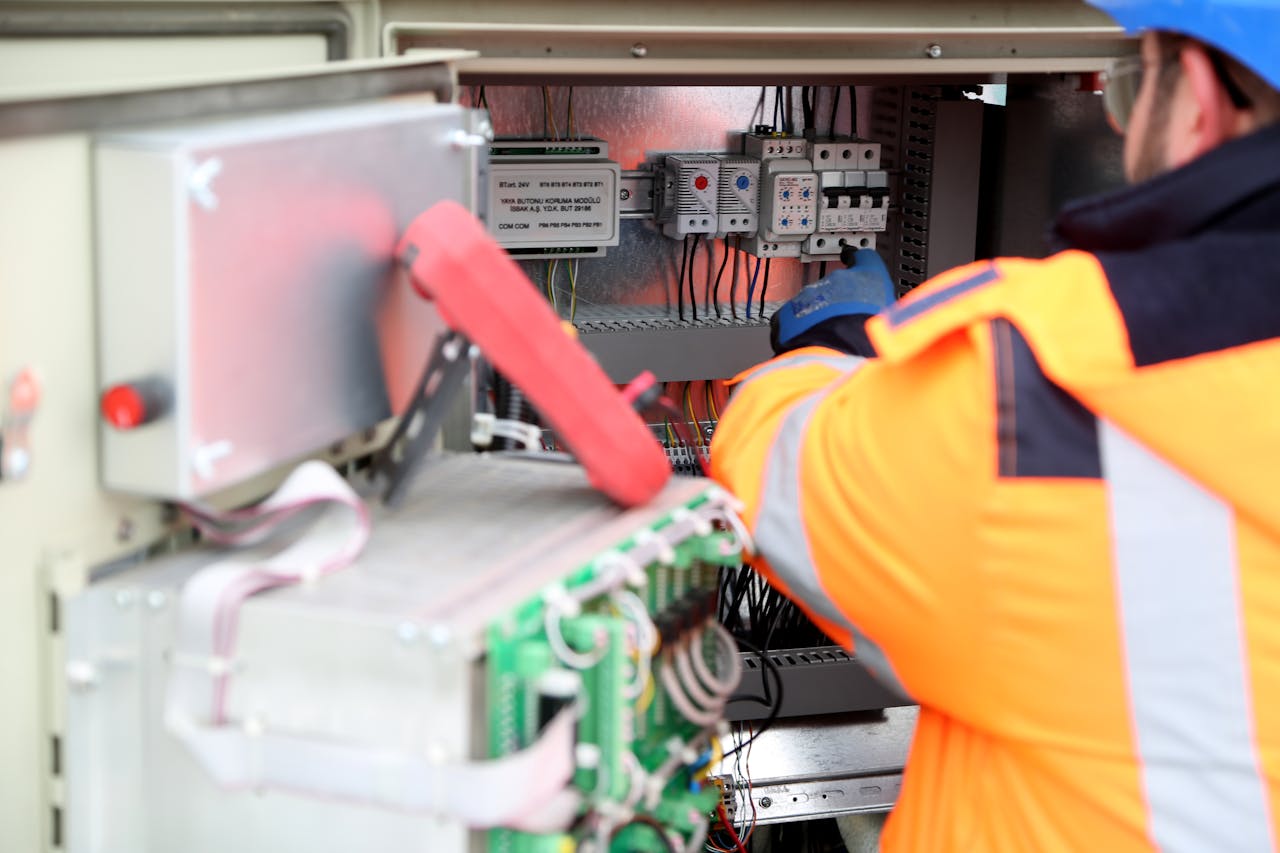Table of Contents
- Understanding Power Factor and Its Importance
- The Role of Power Factor Correction (PFC)
- Real-World Applications: Why Melbourne Businesses Should Invest in PFC
- How to Choose the Right Commercial Electrician for PFC Installation in Melbourne
- Step-by-Step Guide: Preparing Your Business for a PFC Installation
- The Technical Edge: PFC Equipment and Technologies
- Local Regulations and Best Practices in Melbourne
- Practical Tips for Implementing Power Factor Correction
- Success Stories: How Melbourne Businesses Benefitted from PFC
- The Future of PFC in Melbourne: Trends and Innovations
- Conclusion
When running a business in Melbourne, managing your operating costs and ensuring efficiency is crucial. One area that often gets overlooked until problems arise is your electrical system’s efficiency, specifically the power factor. Poor power factor can result in higher electricity bills, increased strain on your equipment, and wasted energy. That’s where power factor correction (PFC) comes in. This article will explore the ins and outs of power factor correction in Melbourne, how it affects your commercial operations, and what you need to know about implementing the best solutions. With insights, practical tips, and local advice on codes and best practices, you’ll be equipped to make informed decisions to enhance your commercial electrical efficiency.
In this blog post, we’ll discuss:
- The fundamentals of power factor correction and why it matters.
- How PFC systems, such as capacitor banks and automatic power factor correction mechanisms, work.
- The benefits of improved power quality and reduced reactive power.
- The role of a commercial electrician in Melbourne in installing and maintaining these systems.
- Practical advice on finding the right service provider, preparing your site, and meeting local regulatory requirements.
By the end of this comprehensive guide, you’ll have a clear understanding of how power factor correction can benefit your Melbourne-based business while reducing energy costs and optimizing electrical infrastructure.
Understanding Power Factor and Its Importance
What Is Power Factor?
Power factor is a measurement of how effectively your electrical power is being used. Simply put, it is the ratio of “real power” that performs work (like powering your industrial machines or lighting up your office) to the “apparent power” that is supplied to your system. In an ideal scenario, the power factor is 1 or 100%. However, in many commercial and industrial settings, the power factor is significantly lower due to the presence of inductive loads such as motors, transformers, and fluorescent lights. These loads draw additional current that does not contribute to actual work, creating what is called reactive power.
Causes of Poor Power Factor
Several factors can contribute to a poor power factor, including:
- Inductive Loads: Motors, transformers, and other equipment that rely on electromagnetic fields.
- Non-linear Loads: Computers, LED lights, and variable frequency drives that can generate harmonic distortions.
- Equipment Wear and Tear: Aging machinery might operate less efficiently, affecting the overall power quality.
- Operational Changes: Changes in production levels or the addition of new equipment without adjusting electrical infrastructure accordingly.
Consequences of a Low Power Factor
For business owners, a low power factor isn’t just a technical inconvenience—it can have tangible financial and operational consequences:
- Electricity Bill Increase: Many utilities in Melbourne and across Australia impose charges or penalties for low power factor conditions, meaning you pay more for the same amount of energy.
- Strain on Infrastructure: Excessive reactive power can lead to higher currents in your electrical system, causing additional wear on cables, transformers, and switchgear.
- Reduced Equipment Efficiency: Poor power factor might result in the inefficiencies of machinery, reducing productivity or increasing downtime.
- Compliance Issues: Staying compliant with local electrical codes and standards such as AS/NZS 3000 is crucial, and failed compliance can lead to legal or insurance issues.
The Role of Power Factor Correction (PFC)
What Is Power Factor Correction?
Power factor correction (PFC) involves techniques to increase the power factor of a system. Essentially, it means adding devices that offset the reactive power consumption caused by inductive loads. The most common method is the installation of capacitor banks, which supply the needed reactive power locally, thereby reducing the overall current drawn from the grid.
Types of PFC Systems
- Passive Power Factor Correction:
- Capacitor Banks: These are the most common solution. Capacitors are installed near major load centers to counteract inductive reactance.
- Fixed Installation: Often seen in simple applications where demand variations are predictable.
- Active or Automatic Power Factor Correction:
- Automatic Controllers: These systems continuously monitor the power factor and adjust the level of capacitance based on the varying load conditions.
- Adaptive Solutions: They provide more dynamic response to fluctuating demands, ensuring optimal efficiency at all times.
- Hybrid Systems:
- Combination Approaches: Some installations use both passive and active correction to manage a wide range of load conditions.
How Does PFC Work?
The principle behind PFC is fairly straightforward:
- Reactive Power Compensation: When you introduce capacitor banks into the system, they generate leading reactive power, which offsets the lagging reactive power from inductive loads.
- Voltage Stabilization: Proper correction can help maintain voltage levels, ensuring devices operate within safe limits.
- Reduced Distribution Losses: Since the overall current in the system is reduced, the energy loss in the form of heat is minimized, further boosting efficiency.
Key Benefits of PFC
For commercial property owners and small business operators in Melbourne, the benefits of a well-implemented power factor correction system are significant:
- Reduced Electricity Bills: By reducing the reactive power demand, you can avoid penalty charges imposed by electricity providers.
- Improved Equipment Lifespan: Lower electrical currents mean less strain on cables and machinery, translating into fewer repairs and replacements.
- Enhanced System Efficiency: With improved voltage regulation and reduced energy loss, overall system performance is heightened.
- Compliance with Electrical Codes: Up-to-date PFC installations help ensure your business remains compliant with local electrical standards and safety regulations.
- Environmental Benefits: Improved energy efficiency contributes to a reduction in your overall carbon footprint.
Real-World Applications: Why Melbourne Businesses Should Invest in PFC
Financial Savings
When you’ve got a thriving business, every dollar counts. PFC systems can cut your power bills by eliminating the penalties associated with low power factor conditions and reducing the demand charge portion of your bill. Commercial properties, especially in energy-intensive industries, stand to benefit the most, with some businesses reporting savings of up to 10% or more on energy costs.
Operational Reliability
Power factor correction can play a significant role in enhancing the reliability and longevity of your equipment. When electrical systems run efficiently:
- Reduced Heat Damage: Lower currents mean less heat generation, reducing the risk of overheating and potential failure in electrical components.
- Minimized Downtime: With fewer electrical anomalies and power quality issues, your business can operate with fewer interruptions.
- Optimal Inventory Operations: For warehouses, factories, and even tech offices, maintaining a stable electrical supply is crucial to avoid costly downtime.
Enhanced System Resilience
Integrating PFC can improve the overall health of your electrical infrastructure:
- Balanced Loads: By managing reactive power, you ensure a more balanced load on the system, which can mitigate transient over-voltage issues.
- Peak Demand Management: Many PFC solutions also help in managing peak demand, a common time for voltage dips or surges that might damage sensitive equipment.
- Voltage Stabilization: Maintaining consistent voltage levels is not only good for your machinery but also critical for ensuring that your data centers and digital systems operate without interruptions.
Environmental and Sustainable Benefits
Modern businesses are increasingly aiming to reduce their environmental impact. Enhancing power quality through correction can:
- Reduce Carbon Footprint: Lower energy waste translates directly into reduced carbon emissions. This is a win for sustainability initiatives.
- Support Green Certification: Businesses looking to obtain green building certifications or optimize their energy management systems will find that improved electrical efficiency is a substantial step in the right direction.
How to Choose the Right Commercial Electrician for PFC Installation in Melbourne
For small business owners and commercial property managers, entrusting electrical work to the right expert is paramount. Here are some tips on choosing a commercial electrician specialised in power factor correction services in Melbourne:
Experience and Specialisation
- Look for Experience in PFC Systems: Ask potential contractors about their experience specifically with power factor correction systems, including passive and active installations.
- Check Credentials: Ensure the electrician is fully licensed and has a deep understanding of Australian standards and local regulations such as AS/NZS 3000.
- Review Past Projects: Request references or case studies of completed power factor correction installations. Seeing practical examples provides assurance of their expertise.
Technical Capabilities
- Power Factor Analysis: The best electricians will conduct thorough power factor testing before suggesting a tailored solution.
- Capacity for Load Management: Ensure your service provider understands electrical load management and how to design systems that handle peak demand efficiently.
- Knowledge in PFC Equipment: From capacitor banks to advanced PFC controllers, your electrician should have familiarity with the latest PFC equipment and technologies.
Local Knowledge and Compliance
- Understanding of Melbourne’s Electrical Codes: A local electrician should be up-to-date with Melbourne’s electrical compliance requirements and best practices in the industry.
- Familiarity with Utility Regulations: Since electricity billing and rating might require specific power factor correction standards, ensure the electrician can navigate Melbourne’s utility guidelines effectively.
Customer Service and Support
- Responsive Maintenance Services: Beyond installation, regular maintenance is essential for lasting PFC performance. Look for a commercial electrician in Melbourne known for excellent after-sales service.
- Clear Communication: Your contractor should be able to explain technical details in layman’s terms and provide a clear roadmap for the installation process.
- Transparent Pricing: Quality service does not need to come with hidden fees. Request detailed quotes and check reviews for transparency and reliability.
Step-by-Step Guide: Preparing Your Business for a PFC Installation
1. Conduct an Electrical Energy Audit
Before implementing any PFC solution, it’s vital to understand your current energy consumption patterns. An electrical energy audit is a comprehensive evaluation of your electrical system, including:
- Load Analysis: Determining which equipment or systems exhibit low power factor conditions.
- Electrical System Mapping: Identifying areas where reactive power consumption is high.
- Cost Assessment: Calculating how much you’re currently paying for penalties and inefficient energy usage.
By doing this audit, you will have a baseline understanding of where improvements are needed and can measure the benefits of your PFC installation afterward.
2. Schedule a Site Inspection
Coordinate with a reputable Melbourne-based commercial electrician to inspect your facility. During this visit:
- Discuss Your Goals: Whether it’s reducing electricity bills or improving overall equipment efficiency, make your specific needs clear.
- Review Past Energy Audits: Share any audit results or electrical schematics that highlight problem areas.
- Site Feasibility: The electrician should evaluate where capacitor banks or other PFC equipment can be installed for maximum benefit.
3. Create an Installation Plan
With the insights from your audit and site inspection, your electrician can help develop a detailed plan that includes:
- Site Layout: How and where the PFC systems will be installed.
- Installation Timeline: A clear schedule from start to finish to minimise operational disruption.
- Cost Breakdown: A transparent explanation of equipment, labor, and ongoing maintenance fees.
- Compliance Strategy: Steps to ensure the project meets Melbourne’s electrical regulations and Australian standards (AS/NZS).
4. Prepare for Installation Day
On the day of installation, there are a few practical steps to take:
- Ensure Accessibility: Clear the designated areas where installations will occur, removing obstructions and securing sensitive equipment.
- Notify Your Team: Inform your staff about the scheduled work, including any areas that will be temporarily off-limits.
- Backup Systems: For businesses dependent on continuous operations, have contingency plans in place or schedule the installation during off-peak hours.
5. Post-Installation
After the PFC system is installed, continue proactive management:
- Regular Testing: Schedule regular power factor analysis sessions to ensure your system maintains optimal performance.
- Maintenance Contracts: Consider ongoing maintenance agreements so your commercial electrician in Melbourne can promptly address any issues.
- Review Utility Bills: Monitor your electricity bills to confirm that you are benefiting from the energy cost reductions promised by the installation.
The Technical Edge: PFC Equipment and Technologies
Commercial properties have various options when it comes to equipment designed for power factor correction. Familiarising yourself with these technologies will empower you to discuss requirements with your electrical consultant confidently.
Capacitor Banks Melbourne
Capacitor banks are a popular and proven solution for PFC. They work by:
- Providing Reactive Power: The capacitors supply the necessary correction current to offset the lag associated with inductive loads.
- Modular Installation: These banks can be scaled up or down based on the current needs of your business.
- Cost-Effective Investment: Compared to extensive rewiring or complete system upgrades, capacitor banks offer a relatively low investment for substantial power factor improvements.
Automatic Power Factor Correction Systems
For businesses with fluctuating loads, automatic PFC systems offer the following advantages:
- Dynamic Adjustment: These systems continuously monitor load conditions and adjust the capacitance in real time.
- Enhanced Precision: Automatic systems help maintain the power factor near the desired level automatically, which is especially useful in industrial settings where loads vary widely throughout the day.
- Integration Capabilities: These systems can be integrated with power monitoring systems to provide detailed analytics and help optimise energy management systems across your facility.
Passive Versus Active Solutions
- Passive Power Factor Correction: Ideal for environments with relatively stable loads, passive systems using fixed capacitor banks may suffice.
- Active Power Factor Correction: In contrast, active systems offer more flexibility for businesses where the electrical load changes frequently. They are particularly useful for commercial electricians handling dynamic and high-precision environments.
Supplementary Technologies: Harmonic Filtering and Voltage Stabilization
While power factor correction addresses reactive power issues, many modern PFC systems also incorporate:
- Harmonic Filtering: To mitigate distortions caused by non-linear loads, ensuring your equipment receives clean electricity.
- Voltage Stabilizers: Integrated solutions help maintain a consistent voltage level, reducing the risk of equipment malfunction or damage.
Local Regulations and Best Practices in Melbourne
When implementing a power factor correction solution, it’s critical to comply with local regulations and standards. In Melbourne, adherence to electrical codes is non-negotiable, ensuring safety and reliability for your commercial building.
Understanding AS/NZS 3000
AS/NZS 3000, commonly known as the Wiring Rules, outlines essential standards for electrical installations in Australia. Key points to consider include:
- Safety Requirements: Ensuring that any PFC installations do not compromise the overall safety of the electrical system.
- Installation Practices: Adopting best practices for cable management, grounding, and the integration of capacitor banks or other correction equipment.
- Inspection and Certification: After installation, having the system inspected and certified is critical to meet legal and insurance requirements.
Utility Regulations in Melbourne
Melbourne’s electricity providers often monitor power factor as part of their billing criteria. Some points of note include:
- Demand Charges: Utilities may impose additional charges if the power factor falls below a specified threshold. Implementing PFC can reduce these charges substantially.
- Metering and Monitoring: Ensure your PFC installation is compatible with existing power monitoring systems so you can track improvements in real time.
- Incentive Programs: Some electricity suppliers may offer rebates or incentives for upgrading to energy-efficient solutions, including power factor correction.
Best Practices for Commercial Electrical Contractors
When working with commercial electrical contractors specialising in power factor correction services in Melbourne, ensure that:
- All Equipment Is Certified: Components used in PFC systems should carry the proper certifications to meet Australian standards.
- System Integration Is Seamless: A successful installation often involves integrating PFC systems with your building’s existing electrical infrastructure without disrupting ongoing operations.
- Continuous Training: The contractor’s team should be well-trained and updated on the latest developments in energy efficiency solutions and electrical engineering services. This ongoing training ensures that they remain at the cutting edge of technology and local compliance requirements.
Sustainable Electrical Solutions
As Melbourne businesses increasingly focus on sustainable operations and reduce their electrical carbon footprint, incorporating PFC into your electrical infrastructure is a smart move. Efficient systems:
- Reduce Greenhouse Gas Emissions: By lowering energy waste, you contribute to environmental sustainability.
- Support Renewable Initiatives: An efficient electrical system can be more easily integrated with renewable energy sources, like solar or wind, further boosting your green credentials.
- Enhance Property Value: Up-to-date and compliant electrical systems are attractive to investors, buyers, and tenants looking for modern, sustainable properties.
Practical Tips for Implementing Power Factor Correction
Implementing a power factor correction solution can seem daunting, but with careful planning and reliable professional support, the process can be straightforward. Here are some practical tips for business owners:
Do Your Homework
- Understand the Basics: Familiarise yourself with the fundamental concepts of power factor correction. Knowing why your building’s power factor can affect costs helps in making informed decisions.
- Get Multiple Quotes: Consult with several commercial electricians in Melbourne to compare services, quotes, and suggested solutions. Don’t settle on the first offer—comparing insights can reveal the best suited option for your business needs.
Maintain Open Communication
- Regular Updates: During the installation process, ensure that your contractor provides regular updates. This transparency will help you anticipate any challenges and prevent costly delays.
- Post-Installation Training: Once the PFC system is installed, ask for a training session or detailed manual on how to monitor the system’s performance and what signs to watch for that might indicate maintenance needs.
Invest in Quality Equipment
- Certified Components: Ensure that all equipment used in your power factor correction system is certified and complies with Australian standards. Investing in quality components from reliable sources reduces the risk of early failure or performance issues.
- Future-Proofing: Discuss with your electrician about the scalability of the system. As your business grows, your electrical demand might increase. Having a system that scales up with your needs can be a wise long-term investment.
Consider the Total Cost of Ownership
- Initial Investment vs. Long-Term Savings: While the installation of PFC systems might require an upfront cost, the long-term savings on electricity bills and reduced penalties can outweigh the initial expenditure.
- Maintenance Contracts: Establish ongoing maintenance agreements. Regular check-ups ensure that your PFC system continues to operate at peak efficiency and can often catch potential issues before they escalate.
Monitor and Evaluate
- Set Benchmarks: After installation, monitor your power factor and energy bills to evaluate the effectiveness of the system. Comparing pre-installation audit data with post-installation results can help you quantify the benefits.
- Leverage Technology: Use power monitoring systems provided as part of your PFC installation to gather real-time data and adjust your operational strategies accordingly.
Success Stories: How Melbourne Businesses Benefitted from PFC
Consider these real-world examples that illustrate the potential benefits of power factor correction:
Example 1: Warehouse and Distribution Centre
A large distribution centre in Melbourne was facing significant penalties due to a consistently low power factor. After undergoing an electrical energy audit, they installed a combination of capacitor banks and an active PFC system. The results included:
- A reduction in overall energy costs by nearly 12%.
- Improved voltage stability, which extended the lifespan of critical warehouse machinery.
- A marked decrease in penalty charges from the electricity provider.
Example 2: Manufacturing Facility
A manufacturing company operating in Melbourne implemented power factor correction alongside other energy efficiency solutions. Their proactive approach involved:
- Detailed power factor analysis and load management planning.
- Installation of a hybrid PFC system that adapted to fluctuating production demands.
- Integration with existing energy management systems for real-time monitoring.
Post-installation measurements indicated:
- A noticeable improvement in system efficiency and reduced downtime.
- Enhanced productivity due to fewer electrical anomalies.
- Long-term cost savings that justified the initial investment in electrical infrastructure upgrades.
Example 3: Commercial Office Complex
An office complex in the heart of Melbourne was struggling with inefficient energy use and maintenance issues related to poor power factor. By engaging experienced commercial electrical contractors, they:
- Installed passive capacitor banks across key areas of the building.
- Conducted a comprehensive electrical energy audit to identify critical load areas.
- Developed a tailored maintenance plan in conjunction with their electrician.
The outcome was a more balanced load distribution, reduced energy losses, and improved overall reliability, which not only reduced operational costs but also supported their sustainability initiatives.
The Future of PFC in Melbourne: Trends and Innovations
As technology evolves, new methods of enhancing electrical efficiency continue to emerge. Here are a few trends to watch in the coming years:
Smart Grid Integration
With Melbourne’s push towards smarter energy management, PFC systems are increasingly being integrated into broader smart grid solutions. This enables:
- Real-Time Energy Data: Businesses can access comprehensive dashboards displaying power factor, voltage levels, and overall energy consumption.
- Automated Adjustments: Smart grids allow for more sophisticated control of electrical loads, making automatic power factor correction even more effective.
- Data-Driven Decisions: Enhanced analytics capabilities provide insights, supporting further energy management initiatives.
Enhanced Monitoring Systems
Modern PFC installations often come with advanced power monitoring systems that offer:
- Predictive Maintenance: Using analytics to forecast when maintenance might be needed, thus avoiding unexpected outages.
- Detailed Reporting: Data-driven insights into system performance, which can inform further upgrades and operational strategies.
- Remote Management: Capability for commercial electricians to monitor and adjust systems off-site, reducing downtime and operational interruption.
Sustainability and Green Electrical Solutions
There’s a growing emphasis on sustainable electrical solutions across Melbourne. As businesses seek to reduce their carbon footprint:
- Integration with Renewable Energy: PFC systems can work in tandem with solar panels or wind turbines, ensuring that even the energy from renewable sources is used efficiently.
- Certifications and Incentives: Energy efficiency certifications increasingly form an integral part of commercial property management, offering benefits such as lower insurance premiums and potential government rebates.
Conclusion
For commercial property owners and small business operators in Melbourne, power factor correction represents an essential investment in energy efficiency and operational reliability. Whether you’re dealing with penalty charges, frequent equipment maintenance issues, or simply looking to optimise your overall electrical system performance, a well-planned PFC installation can deliver lasting benefits.
By working with experienced commercial electricians who understand local regulations and modern energy management trends, you can improve your facility’s power quality, reduce energy costs, and create a more sustainable operation. From capacitor banks to automatic correction systems, the available technology ensures that every business, regardless of size, has the opportunity to benefit from enhanced electrical efficiency.
Remember, taking proactive steps—starting with an electrical energy audit and engaging with a qualified Melbourne commercial electrician—will pave the way towards a more efficient, reliable, and cost-effective electrical system. In today’s competitive business environment, every watt counts.
Embrace power factor correction as a vital component of your energy management strategy, and set your business on the path to a brighter, more efficient future.
With the insights shared above, you’re now well-equipped to investigate, discuss, and implement a power factor correction solution tailored to your business needs in Melbourne. Not only can this system help you overcome common challenges like reactive power compensation and harmonic filtering, but it can also position your company as a leader in operational efficiency and sustainability.
If you’re ready to take the next step toward enhanced electrical efficiency, consider reaching out to local experts in power factor correction services, commercial electricians, and electrical consultants Melbourne. Whether you’re scaling up a manufacturing facility, optimizing an office complex, or modernizing a distribution centre, the right PFC solution can transform your operations—saving money, reducing energy consumption, and ensuring your electrical systems are future-proof.
Here’s to a more efficient, sustainable, and profitable future in Melbourne’s vibrant commercial landscape!





0 Comments